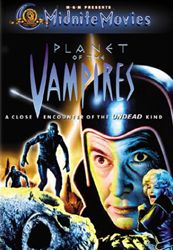
|
PLANET OF THE VAMPIRES REVIEW BY DEREK HILL
Planet of the Vampires (aka Demon Planet for U.S. television audiences), Bava’s 1965 melding of the horror and science-fiction genres, is a tour-de-force of otherworldly visuals, muscular comic book plotting and lean suspenseful thrills. The film may lack much of the overt fetishistic eroticism of Bava’s best work, but it nevertheless has a ravishing sheen. The plot is simple enough: the crew of the space ship Argos, led by the almost pathologically serious Captain Mark Markary (Barry Sullivan), lands on a strange desolate planet called Aura to rescue another ship, the Galliot. But upon landing, some of the Argos’ crew undergoes a change. Crewmembers become violent, feral beasts – then suddenly return to normal. Things do not get any easier once Markary and a small search party reach the Galliot – after traversing a fantastically dangerous landscape of swirling colors and bubbling lava flows – and subsequently find most of the crew dead or delirious. Soon, things get even more freaky when the Galliot dead return to life, rising from their makeshift graves (one of the film’s most horrific and amazing moments) and start preying upon the living. From the eerie opening sequence of the Argos adrift in space to the synthetically nightmarish vision of the space vampires wrapped in plastic and rising from their metallic tombs to the startling yet inevitably ironic ending, Planet of the Vampires delivers the goods. Granted, some of the film’s visual effects are unconvincing (even for the time), most notably the scenes of the Argos descending through the thick soupy clouds and landing on the planet. These scenes betray the fact that they were filmed in an underwater tank, as bubbles drip up off the hull of the ship into the sky. But for the most part, Bava’s extraordinary skill at making the most of his limited budget works wonders, and there are very few visual gaffes to distract one from the almost hypnotic power the film generates. Much of the movie's hallucinatory spell is sustained by its wonderfully deadpan acting and composer Gino Marinuzzi Jr.’s excellent score, replete with spacey electronic cues that recall Forbidden Planet’s (1955) distinctive music. Bava’s inspired production design – especially during the sequence when Markary and his beautiful assistant Sanya (Norma Bengell) discover the ancient bones of a gigantic alien creature within its own space ship – also has a familiar feel to it. Not surprisingly, Bava’s film (along with It! The Terror from Beyond Space, 1958) was a direct influence on Ridley Scott’s 1979 big budget B-movie Alien.
Planet of the Vampires was originally released stateside by AIP and was subsequently cut by a few minutes. MGM’s DVD of the film is a beautiful re-mastering job combining both the Italian and the American versions. As part of MGM’s ongoing Midnight Movies label, Planet of the Vampires lacks any extras other than an appropriately hysterical theatrical trailer. But considering how amazing the transfer looks and the quality of the English-dubbed mono soundtrack, things could be far worse, like the omission of Marinuzzi Jr.’s original score. When released on the Thorn/EMI video label back in the mid-'80s, the music for Planet of the Vampires (along with other titles then owned by Orion Pictures) was given a new synthesizer score by a Los Angeles-based musician by the name of Kendall Schmidt. The reasons for re-scoring the films had more to do with copyright issues than aesthetics, though Schmidt’s score was the only available version for many years. Thankfully, MGM has rectified the matter. Planet of the Vampires is available in its original theatrical ratio of 1.85:1 and the picture looks sharp and perfectly balanced throughout. The super-saturated color scheme, which could have caused havoc, looks stunning and can now be properly reevaluated as one of the director’s most visually unforgettable creations.
Planet of the Vampires is now available on DVD from MGM in its original aspect ratio of 1.85:1. Suggested retail price: $14.95. For additional information, we suggest you check out the MGM Video Web site.
|
 Although director Mario Bava is understandably better known for his gothic horror films, his frequent cinematic excursions into other genres were just as accomplished and entertaining. His lush hallucinatory style may have formed a perfect unholy matrimony with the gothic, but Bava’s deliciously satanic cinematic talent was also adaptable to the western (The Road to Fort Alamo, 1965), the epic (Erik the Conqueror, 1961, or Knives of the Avenger, 1967) or the spy-thriller (his 1968 pop-art masterpiece Danger: Diabolik) genres.
Although director Mario Bava is understandably better known for his gothic horror films, his frequent cinematic excursions into other genres were just as accomplished and entertaining. His lush hallucinatory style may have formed a perfect unholy matrimony with the gothic, but Bava’s deliciously satanic cinematic talent was also adaptable to the western (The Road to Fort Alamo, 1965), the epic (Erik the Conqueror, 1961, or Knives of the Avenger, 1967) or the spy-thriller (his 1968 pop-art masterpiece Danger: Diabolik) genres.

